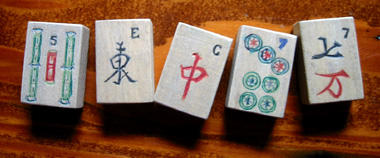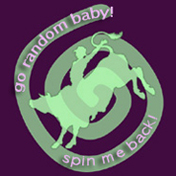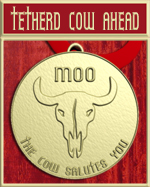Wed 28 Dec 2005
White Dragon
Posted by anaglyph under Ephemera, Whimsy
[6] Comments

I really love the Chinese game of Mahjongg, a beautifully simple, elegant and peaceful game that has a complex history, a grand tradition and is played widely to this day across the world. Mahjongg was introduced to the West in the 1920s via America.
My dad, who knows nothing about Mahjongg, but knows I love it, gave me this beautiful set for Christmas. He picked it up at a local market and was entirely unsure of its value or even if the game was intact. By doing a search on some faint text on the box I was able to determine that it is an English version made in the early 1920s by the Chad Valley Mahjongg Company. It is complete except for dice and counters which are not crucial and are easily substituted. There is a delightful ‘hand-made’ quality about the set and it speaks of an age where machines did not spew things out with rigorous precision and in vast quantities.
The tiles in the picture above are, from left to right:
The five of Bamboo (or Sticks), the East Wind, The Red Dragon, the seven of Circles (or Coins, or Dots) and the seven of Characters (or Numbers, or Cracks).




An 80 year old set, languishing at a local market. Amazing. My Mahjongg playing experience consists of a solitaire-type game on an old Palm III. I’ve no idea how to play a “real” game.
Yet.
So, the White Dragon – in your Mysterious Corner, or pseudonym for same?
Do them five tiles beat a full house?
But seriosly … Is th game tuff t learn? Do you no many othrs who play it? An does a game require a set number of players?
Im sure I got yer dad beat, when it comes t ignorance of th game.
I don’t know how to play, but those tiles look like objects I would just love to have around to be able to touch.
Joey: There are many similarities between Mahjongg and cards. Descriptions of the game often say it’s closest to Gin Rummy, but that’s a largely superficial comparision.
It is very easy to learn, but the winning strategies are subtle and complex. Like all good games there is a finely tuned balance of luck and skill involved.
You might be interested to know that in America Mahjongg is often mistakenly thought to be a Jewish game because it was originally widely adopted by Jewish women in 1920s America. The National Mahjongg League was founded by Jewish players.
Yeah, I remembr learnin that th game is Chinese in origin. I remembr learnin that cause at th time, I DID think of it as bound up wit Jewish culture. Miss Daisy playd Mahjongg.
Only aftr readin yer post did I learn hownaheck t SPELL th name!